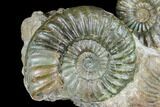This Specimen has been sold.
Great Lower Jurassic Ammonite (Asteroceras) Display - England
This is a displayable piece with a pair of green-colored, Lower Jurassic Asteroceras ammonite fossils. The ammonites measure 4.35" and 2.7" wide and the base of the stone has been cut flat so that it displays nicely without a display stand.
About Ammonites
Ammonites were ancient marine cephalopods, similar to today's squids and octopuses, but with a defining feature: their distinctive, tightly coiled spiral shells. These shells, resembling those of modern nautiluses, served as both a protective home and a buoyancy aid, allowing ammonites to navigate the prehistoric seas with ease. First emerging around 240 million years ago in the Triassic Period, ammonites thrived for over 175 million years, adapting through numerous forms and sizes. As predatory creatures, they likely fed on smaller marine organisms, using their tentacles to capture prey. However, their long reign came to an end 65 million years ago at the close of the Cretaceous, coinciding with the mass extinction event that also eliminated the dinosaurs.
Ammonites were ancient marine cephalopods, similar to today's squids and octopuses, but with a defining feature: their distinctive, tightly coiled spiral shells. These shells, resembling those of modern nautiluses, served as both a protective home and a buoyancy aid, allowing ammonites to navigate the prehistoric seas with ease. First emerging around 240 million years ago in the Triassic Period, ammonites thrived for over 175 million years, adapting through numerous forms and sizes. As predatory creatures, they likely fed on smaller marine organisms, using their tentacles to capture prey. However, their long reign came to an end 65 million years ago at the close of the Cretaceous, coinciding with the mass extinction event that also eliminated the dinosaurs.
SPECIES
Asteroceras sp.
AGE
LOCATION
Dorset, England
FORMATION
Lias Alpha
SIZE
Ammonites 4.35" & 2.7", Rock 8.4 x 5.2 x 2.8
CATEGORY
SUB CATEGORY
ITEM
#175104
We guarantee the authenticity of all of our specimens.
 Reviews
Reviews
















